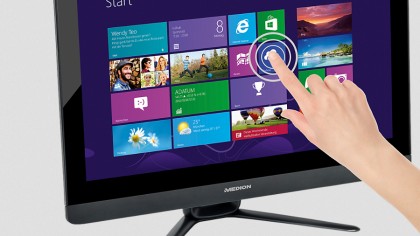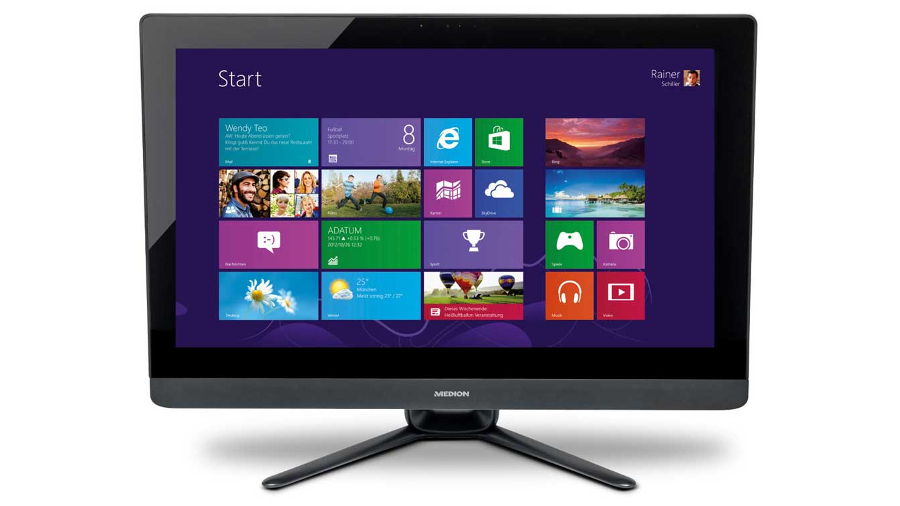TechRadar Verdict
A powerful processor and 8GB of RAM makes the Akoya something of a beast (and good value to boot), but it certainly isn't a beauty.
Pros
- +
Large capacity HDD
- +
Core i7 CPU
- +
8GB RAM
- +
Good value
Cons
- -
Design
- -
Display
- -
Speakers
- -
Port placement
- -
No SSD
Why you can trust TechRadar
Medion is certainly not a household name in the UK but it is a force to be reckoned with in Germany, the biggest market for personal computers in Europe. The company was acquired by Chinese giant Lenovo just over three years ago and was allowed to thrive on its own as the consumer-focused house brand.
Therefore, it doesn't come as a surprise that you can find a myriad of products bearing the Medion name on the latter's website - from smartphones to digital cameras, and blood pressure monitors - in addition to computers.
The P5501 D is part of Medion's Akoya range and is an all-in-one (AiO) computer. This particular form factor has been given a shot in the arm thanks to the touch-friendly nature of Microsoft's Windows 8 (and 8.1) operating system.
Medion has several models in the range, starting at £345 (around £546, or AUS$637) for the 19.5-inch base model that has an Intel Pentium CPU and 4GB of RAM. Our review model lies at the opposite end of the scale, entering the fray with a 23.6-inch, full HD display, Intel i7-4790S Haswell CPU, 2TB HDD and 8GB of RAM. Intel's integrated HD 4600 solution takes care of graphics duties. It sells for at £749 (around $1,185 or AUS$1,383).

Design and specs
AIO PC makers have put out some interesting designs in recent years, but Medion's machine has not been blessed in this department. The Akoya 5501 D is decked in an unassuming two-tone black and grey plastic, with a grey bezel fixed below the 23.6-inch display. A two-prong, crows foot-style stand keeps the display upright and features a practical hole that can be used to slot through cables.
Its LED backlit display is highly reflective and offers only average viewing angles, and its colours aren't the boldest we've seen. There is also a noticeable gap between the display's glass and the screen itself when you touch it to control desktop or Windows apps with your fingers, which is slightly off-putting and not helped by a (very short, but irritating nonetheless) delay in response time.

Buttons to turn on the power and switch between video inputs are found along the back of the machine. They're large and easy to press, but you'll find yourself initially turning around the machine at first to remind yourself what each of them does.
Sign up to the TechRadar Pro newsletter to get all the top news, opinion, features and guidance your business needs to succeed!
The PC comes with a keyboard and mouse, which are serviceable but have an overly plastic feel. The keyboard is of poor construction with keys that possess mushy travel and feel cheap under the fingers. You'll soon find yourself wanting to swap these out for third-party peripherals with better build quality that are more satisfying to use.
Ports and connectivity
Medion has baked a standard set of I/O capabilities into the Akoya PC P5501 D, bundling ports on the left and right edges of the machine, in addition to its rear.
On the left-hand edge is a USB 2.0 HDMI port, headphone and microphone jack, which is accompanied by a Blu-Ray player and 7-in-1 multi-card reader on the right. Turn it around and you will find two USB 3.0, a microphone jack, line out and a LAN connector. There's also HDMI in and HDMI out, meaning you can output the monitor's image to another display, or connect another device to use the Akoya AIO PC as an external display.

Frustratingly, these are placed along the rear edge of the machine and, importantly, low down, making them difficult to access unless you tip the machine over - a frustrating process. In terms of communication options, 802.11ac Wi-Fi is notable in its absence, with 802.11n featuring instead, in addition to Bluetooth 4.0.
Software and media
The machine comes with an underwhelming selection of apps, most of which you'll find more value in erasing to free up space. As is the case with most Windows 8.1 machines, a 30-day trial of Office 2013 is used as bait to reel you into picking up a full subscription to Microsoft's productivity suite.
The outdated Windows Essentials 2012 is also bundled, which includes Windows Movie Maker, Live Mail, Live Writer and Photo Gallery. Aside from a month-long trial of Kaspersky Internet Security, the most useful of the bunch is CyberLink PowerDVD mobile, which plays videos in a multitude of formats and will save you having to buy it from the Windows Store.
Should you decide to use the Akoya as a multimedia machine for playing movies and watching videos, you'll certainly want to pick up a pair of external speakers. The Akoya's border on unlistenable when cranked up to anywhere approaching full volume; bass is muddy and the sound suffers an overall lack of clarity.
Performance
- PCMark 8: 3139 (home), 3312 (work), 3141 (creative)
- Cinebench: CPU: 729cb, Graphics: Wouldn't run
- 3D Mark 2013: Fire Strike: 786, Sky Driver: 3443, Cloud Gate: 7,402, Ice Storm: 65,824
If there's anything positive to say about the Medion AIO PC P5501 D, it's that it offers better performance than you will find in similarly-priced (or even more expensive) models. With a Cinebench R15 score of 729cb, the Akoya's Intel CoreTM i7-4790S CPU (clocked to 3.2GHz) bests even the HP Z1 G2 (661cb), which costs more than £4,000 (around $6,300 or AUS$7,300).
Additionally, its capacious 2TB hard disk drive provides plenty of capacity for storing media, games and other files, which is backed up by a health 8GB of RAM. However, the absence of an SSD means that doing general desktop-oriented tasks - from opening desktop apps to booting up and shutting down - isn't quite as nippy as it could be. Integrated Intel HD 4600 graphics means that you'll only be able to run modest games on low details at resolutions.
On the other hand, it managed to chew through editing large image files with ease, showing very little delay when scaling a 300MB image file up and down in GIMP. Additionally, we experienced little-to-no slowdown when continuing to edit with two browsers open with 10 tabs each and a 1080p YouTube video playing in the background.

